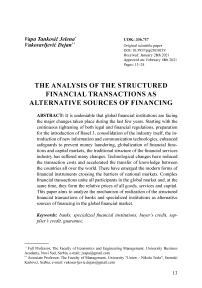The analysis of the structured financial transactions as alternative sources of financing
Автор: Jelena Vapa Tankosić , Dejan Vukosavljević
Журнал: Pravo - teorija i praksa @pravni-fakultet
Рубрика: Original scientific work
Статья в выпуске: 1 vol.38, 2021 года.
Бесплатный доступ
It is undeniable that global financial institutions are facing the major changes taken place during the last few years. Starting with the continuous tightening of both legal and financial regulations, preparation for the introduction of Basel 3, consolidation of the industry itself, the introduction of new information and communication technologies, enhanced safeguards to prevent money laundering, globalization of financial functions and capital markets, the traditional structure of the financial services industry has suffered many changes. Technological changes have reduced the transaction costs and accelerated the transfer of knowledge between the countries all over the world. There have emerged the modern forms of financial instruments crossing the barriers of national markets. Complex financial transactions unite all participants in the global market and, at the same time, they form the relative prices of all goods, services and capital. This paper aims to analyze the mechanism of realization of the structured financial transactions of banks and specialized institutions as alternative sources of financing in the global financial market.
Banks, specialized financial institutions, buyer’s credit, supplier’s credit, guarantee
Короткий адрес: https://sciup.org/170202239
IDR: 170202239 | УДК: 336.717 | DOI: 10.5937/ptp2101013V
Список литературы The analysis of the structured financial transactions as alternative sources of financing
- Auboin, M. (2007). Boosting trade finance in developing countries: what link with the WTO?. World Trade Organisation Staff Working Paper ERSD-2007-04. DOI: 10.2139/ssrn.1086278,
- Chauffour, J.P., Saborowski, C., & Soylemezoglu, A. I. (2010). Trade Finance in Crisis: Should Developing Countries Establish Export Credit Agencies?. World Bank Policy Research Working Paper 5166. DOI: 10.1596/1813-9450-5166.
- Comunale, M., Geis, A., Gkrintzalis, I., Moder, I., Polgár, É. K., Quaglietti, L., & Savelin, L. (2019). Financial stability assessment for EU candidate countries and potential candidates. Occasional Paper Series 233. DOI:10.2866/447001
- Dušanić, J. (2003). Poslovno bankarstvo [Business banking]. Srpsko Sarajevo: Konseko institute
- Fingerand, K.M., & Schuknech L. (1999). Trade, Finance, and Financial Crisis, Special Studies 3. Geneva: World Trade Organization
- Gianturco, D. (2001). Export Credit Agencies: the Unsung Giants of International Trade and Finance. Westport CT: Quorum Books
- Hellqvist, M. (2003). Trade Facilitation from a Developing Country Perspective. Stockholm: Swedish National Board of Trade
- MIGA (2010). World Investment and Political Risk. Downloaded 2020, June 12 from http://www.miga.org/documents/WIPR10ebook.pdf
- Moravcsik, A. (1989). Disciplining Trade Finance: the OECD Export Credit Arrangement. International Organization, 43(1), pp. 173–205. DOI: https://doi.org/10.1017/S0020818300004598
- OECD (2018). The arrangement on officially supported export credits. Downloaded 2020, June 14 from http://www.oecd.org/ofcialdocuments/publicdisplaydocumentpdf/?doclanguage=en&cote=tad/pg(2018)
- Park, A., Nayyar, G., & Low P. (2013). Supply Chain Perspectives and Issues: A Literature Review. Geneva: WTO
- Vapa Tankosić, J. (2009a). Fostering Trade in Overcoming the Global Economic Crisis. International Journal of Euro-Mediterranean Studies (IJEMS), 2(1), pp. 79–97, Downloaded 2020, June 22 from https://emuni.si/wp-content/uploads/2019/02/2_079-097.pdf
- Vapa Tankosić, J. (2009b). Dinamika razvoja međunarodne regulative u oblasti osiguranja i finansiranja izvoza uz podršku države: OECD Konsenzus [Dynamics of development of international regulations in the field of export insurance and financing with the support of the state: OECD Consensus]. Pravo, teorija i praksa, 26 (1-2), pp. 85–104
- Vapa Tankosić, J., & Jevtić, A. (2010). Export Finance: A Key to Economic Recovery. In: Grabara, Ј., Skowron-Grabowska, B., Hanić, H., Erić D. (eds.) Global Crisis in the Central-Eastern European Region Influence on financial systems and small and medium-sized enterprises (pp. 146–156). Belgrade: The Institute of Economic Sciences in Belgrade
- Vapa Tankosić, J. (2010). Promene u poslovanju agencija za osiguranje i finansiranje izvoza [Changes in the operations of export insurance and financing agencies]. Zbornik Matice Srpske za društvene nauke, (133), pp. 119–131
- Vapa Tankosić, J., Redžepagić, S., & Stojsavljević, M. (2013). Trade, Regional Integration and Economic Growth: MEDA Region and the Western Balkan Countries. In: Peeters, M., Sabri, N., Shahin, W. (eds.),Financial Integration. Financial and Monetary Policy Studies, 36 (pp. 215–229). Berlin, Heidelberg: Springer, https://doi.org/10.1007/978-3-642-35697-1_12
- Vapa Tankosić, J. & Soleša, D. (2016). Strategic management models of public export credit agencies in times of crisis. In: Smoljić, M., Belaj, I. (eds.), Development of public administration (pp. 410–429). Vukovar: Veleučilište Lavoslav Ružička
- Yescombe, E. R. (2002). Principles of Project Finance. London: Academic Press
- Zakon o Agenciji za osiguranje i finansiranje izvoza Republike Srbije [Law on the Export and Export Finance Agency of the Republic of Serbia]. Službeni glasnik RS, no. 61/05


